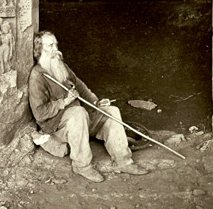Robert Gill
| Robert Gill | |
|---|---|

Gill at Ajanta
|
|
| Born |
26 September 1804 Hackney, London, England |
| Died | 10 April 1879 (aged 74) en route from Ajanta to Bhusawal, India. |
| Resting place | Catholic Cemetery, Bhusawal 21°3′2.39″N 75°47′43.47″E / 21.0506639°N 75.7954083°E |
| Occupation | Army officer, artist, photographer, sportsman |
| Known for | copying the paintings of Ajanta caves. |
| Spouse(s) | Frances Flowerdew Rickerby |
| Partner(s) | Paro, a native girl of Ajanta another woman after the death of Paro. |
Major Robert Gill (1804–1879) was an army officer, antiquarian, painter and photographer in British India. He is best known for his paintings copying the frescoes of the Ajanta caves. Gill was the first painter – after their rediscovery in 1819 – to make extensive copies of the Buddhist cave paintings, which mostly date to the 5th century CE. His surviving copies and drawings remain significant in Ajanta studies as the originals have significantly deteriorated since his time.
Gill was born in Hackney, London, the son of a stockbroker. On 25 May 1825, he married Frances Flowerdew Rickerby at St Luke's Church, Chelsea, in London. He had joined the 44th Madras Native Infantry as a cadet the previous year, and became an ensign on 6 May 1825, immediately before his marriage. Promotion to Lieutenant followed in September 1826, and to Captain on 6 May 1840; finally he was promoted to Major. He was discharged as an invalid on 1 October 1852. His first child, a daughter called Frances Eliza Minchin Gill (1842-1930), was born in Madras. His first son, the soldier, explorer and intelligence officer William John Gill (1843-1882), was born in Bangalore. A second daughter, Rose Matilda Gill, was born in Chelsea in 1845 but died when less than three weeks old. A second son, the lawyer Robert Thomas Gill (1847-1927) was born in Jaulnah, as was a third daughter, Lucy Annie Gill (1849-1903). Robert Gill may have had several children who died in infancy by his first Indian mistress, Paro. He had two daughters by his second Indian mistress: Mildred Mary Gill (1866-1923) and Annie Gill (c.1864-1934).
Gill was a member of The Royal Asiatic Society, and this association was eventually parlayed into copying the murals that had first been published in a lecture by James Fergusson to the Bombay branch of the Society, and later inclusion and illustration in his book in Indian rock-cut architecture. From 1844, Gill was taken away from military service to copy the Ajanta murals for the Asiatic Society of Bombay, at an additional salary of 200 rupees a year. He spent thirty years measuring, mapping, cataloguing, photographing, and painting in the caves, despite dangers from wild animals and the local Bhil people.
...
Wikipedia
